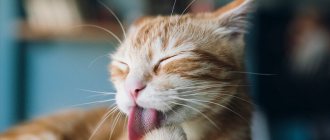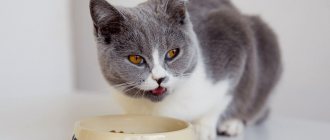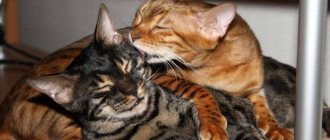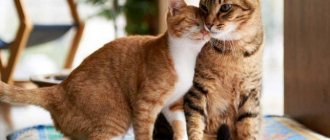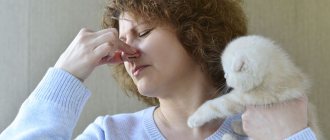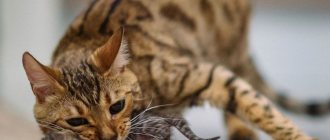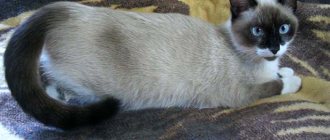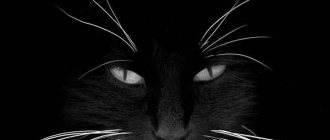Sometimes inexperienced owners are surprised: why does a cat twitch in its sleep? There is no need to panic, for animals it is as natural as for a person to talk in a dream. One cat twitches more often in its sleep, another almost never, this is very individual among cats.
Sometimes, inexperienced owners are surprised that the kitten twitches in its sleep, and may even make strange sounds: sometimes purr, sometimes “cry out.” This behavior during sleep is quite natural for animals; this is not at all an indication that the pet is sick with something.
Like people, our smaller brothers have certain sleep phases. At the same time, in cats, the duration of “deep” sleep is about a quarter of the total time spent in blissful slumber. And yet, why does this happen, why does a cat twitch in its sleep?
It may seem like cats are terrible lazy people, because they sleep most of the day, but in fact, this is not entirely true. What looks like sleep is often simply a state of relaxation, with the animal in control of everything that happens around it. Have you probably noticed that a “sleeping” cat opens one eye slightly as soon as some movement occurs?
So, when a cat decides to take a nap, she curls up, gets comfortable, and relaxes all her muscles. The shallow sleep phase begins, and after about 10-30 minutes it gives way to deep sleep.
During this period, the muscles are completely relaxed, the cat lies on its side. And then, when the animal is truly asleep, noticeable movements of the tail, ears, and limbs occur, and the cat twitches in its sleep.
A person, unlike cats, while in this phase of sleep, dreams. In this special state of the brain, information about recent events is transferred to deeper layers of memory from its “temporary” section. Cats probably experience similar experiences.
If a person has developed areas of the brain responsible for psycho-emotional experiences and imagination, then for less developed animals physical movements and motor skills are important. These are what the cat’s brain reproduces, while relaxed muscles sometimes reproduce by inertia.
Periods of deep sleep for cats are about 6-7 minutes. During a long rest there can be many such phases. Therefore, if your pet “talks” or moves in its sleep, do not rush to contact the veterinarian; this is quite normal.
Modern veterinary medicine quite successfully fights many infectious, viral, dermatological, senile and other diseases in cats, but in order to correctly prescribe treatment, it is necessary to take into account the entire complex of symptoms.
Sleep Features
- Experts constantly study the behavior of furry animals, so they made conclusions regarding the sleep phases of cats. The first stage includes sleep of a superficial type, which is comparable to dozing. The animal controls its actions because the body does not relax completely. The pet is aware of what is happening around it and can stand up or open its eyes at any time.
- The second phase includes slow-moving sleep. It is characterized by relaxation of muscle fibers, a decrease in blood circulation, and a slowdown in heart rate and breathing. The individual may open its eyes slightly, as if fighting sleep, then close them again. Everything is done very slowly.
- And finally, the final phase, otherwise called REM sleep. As a rule, it takes no more than 7 minutes. Against this background, breathing changes, becoming intense at first, then slow and deep, then fast again. The heart is also unstable and may pound or be at rest. Usually the pressure rises, the eyes move, and sometimes the animal makes sharp twitches of its paws, ears, whiskers or tail.
- Studies have been carried out, during which it was possible to find out that it is the last stage that is the period when the pet dreams. The dream is filled with emotions, it turns out to be quite spectacular, and accordingly, the pet reacts to it. The phases are constantly changing and appear one after the other, so the behavior of your furry friend looks different.
Cat dreams
The world of dreams is like an otherworldly universe with its own laws and characteristics. Scientists have long established that animals dream like people, experiencing vivid and dynamic pictures. It is noteworthy that cats made a great contribution to the study of sleep, becoming test subjects in a number of experiments. The purpose of the research was to prove the theory that during the dreaming phase of sleep, people and animals with an intact brain are affected by atonia (lack of muscle tone), which blocks active movements.
Complete relaxation
To help your pussy fall into deep sleep, where twitching may sometimes occur, provide him with a sleeping area that maintains a constant, comfortable temperature. Cats especially feel safe in high places, where they are protected from various stimuli, such as other animals in the house.
At temperatures below 20 degrees, a cat may curl up and hide its nose under its tail, but at higher temperatures, it will tend to gradually relax its position.
Noticing that a cat is twitching in its sleep, the owner may be concerned about the well-being of the pet. If we are talking about an adult cat, suspicions are far from unfounded. Let's figure out why cats twitch in their sleep and what it may indicate if a cat twitches too much.
It was cats, or rather, their dreams, that made it possible to prove to the whole world that animals also plunge into the world of dreams. Moreover, scientists suggest that our pets' dreams are much richer and more dynamic than ours.
It all started when doctors began to study the phases of human sleep. To confirm their assumption that healthy people lose the ability to move during REM sleep, an experiment was conducted on a group of cats.
All animals had a small area of the brain removed, which was responsible for muscle atonia in the REM phase of sleep. After the animals were fully rehabilitated, the scientists' suspicions were corrected. The observed cats stood on their paws, walked confidently, and turned their heads, as if watching someone. While in a state of sleep, cats sniffed and turned their ears. The experiment proved that cats see, hear and touch dreams.
This is interesting!
A healthy, adult animal does not move during REM sleep, although rapid eye movements and slight twitching are considered normal.
With the development of medical equipment, it was possible to prove that during dreams, cats experience real emotions: fear, joy, excitement, aggression. Near the animals under observation, “pheromones” of a same-sex cat were sprayed and the observed one showed aggression. In the opposite case, when the scent of an animal of the opposite sex was sprayed, the observed behaved calmly or interestedly. That is, animals not paralyzed by the REM phase not only sensed the outside world, but also made natural, instinctive decisions. These observations led to the conclusion that in their dreams, cats see themselves and their surroundings very realistically.
This is interesting!
Experiments were carried out on cats, dogs and rodents. Cats surprised scientists by very naturally emitting hunting in their dreams. The dogs unexpectedly hinted at the animal essence, imitating the behavior of wild wolves. The rodents broke all records, because even in their sleep they were able to solve the tasks assigned to them.
The study of human and animal sleep continues. Of course, today it is no longer practiced to remove part of the brain for the sake of observation. To relieve atonia during the REM phase, blockades of part of the brain are used. Modern scientists are on the verge of a big discovery, since the experiments included observations of brain activity using highly sensitive scanners. There is no doubt that cats dream, but perhaps we will soon find out exactly what their dream world looks like. Already today, scientists have managed to find out that kittens see their first dreams while still in the womb.
Seizures in a cat - reasons that provoke unusual behavior of the pet
If your cat has a seizure, place her on a flat surface.
If your pet is experiencing seizures, you should follow these tips:
- if the animal begins to have convulsions, calm down and do not panic, since in an excited state you will not only not be able to provide first aid, but can also harm the pet;
- Place the animal on a hard, flat surface, such as the floor. In this case, you can place a disposable diaper under the cat, since often during an attack pets experience uncontrolled bowel and bladder emptying;
- Do not under any circumstances try to hold the animal or open its mouth by force in order to insert a stick or other object into it;
- There is no need to try to pour medications into the animal’s mouth, and especially not to push pills.
After an attack, it is necessary to cover the pet with a warm blanket and show the animal to a veterinarian as soon as possible.
Massage helps shorten the duration of an attack and reduce discomfort and pain. At the same time, do not forget that you should not overdo the massage. In order to help your pet, light stroking of the cramped limb will be enough.
The animal's convulsions look quite frightening, and the owner is required not to panic and maintain presence of mind
It is necessary to remove from the animal shaking in fits all objects that could cause physical harm to it if moved carelessly
There is a technique for massaging your pet during an attack.
You can try placing a cat in a state of convulsions on a soft, smooth surface and gently massage the cramped limb. After this, apply a heating pad or any other container with warm water to the animal’s paws and lower back.
The seizure usually lasts less than 5 minutes, but the cat's fear and confusion will continue for quite some time. You can't leave her alone. The owner must calm and comfort the animal with stroking, affection and kind words.
During and after an attack, you can try putting a few drops of Valocordin or Corvalol on your pet’s tongue. These drugs will calm the animal and ease its suffering. No other medications should be given without the advice of a specialist.
After the end of the convulsions, it is advisable to place bowls with water and food at an accessible distance from the cat, given that for some time she cannot orient herself normally in space. It is not recommended to specifically force the animal to eat or drink.
What to do if your pet has seizures? The first step is to protect the animal from possible injury. To do this, you need to remove all objects that the cat might hit during convulsions. You can cover the cat with soft pillows or wrap it in a blanket. At the same time, carefully ensure that the animal does not suffocate in the material.
Do not touch your pet's face with bare hands. During convulsions, the animal is very frightened and does not recognize the owner. This condition can lead to aggression. A cat is capable of scratching and biting its owner.
If possible, reduce various effects on the animal’s nervous system that can prolong an attack or stimulate a new one. Turn off the lights, sounds, avoid touching the body, do not scare.
We suggest you read: Unpretentious fish for the aquarium
It is prohibited to independently prescribe and use medications for an animal. Drugs intended for humans can be fatal for cats. You can call the veterinary clinic and, with the veterinarian’s approval, put a couple of drops of Corvalol or Valacordin on the cat’s tongue. These products will help calm your pet before going to the vet.
Even a single attack of seizures must be reported to a veterinarian, who will conduct a full examination and determine the cause of its occurrence.
To do this, you must place the animal in a closed carrier.
Movements of adult animals during rest
- For the older generation of felines, it is considered normal to twitch their limbs, tail, whiskers or ears. Typically, this happens during the transition period from adolescence. The animal adapts to external changes, new living conditions and other aspects. If the cat had a busy day, it is likely that the dreams will be the same.
- During adolescence, individuals strengthen their psycho-emotional environment, learn about the world more deeply, build relationships with the owner and achieve stability in the nervous system. The animal does not experience any particular stress, so sleep is calm and with periodic movement of the limbs.
- In the older generation, the last stage of sleep is characterized by moving ears, antennae, and lips. Movement of the tail and limbs may also be seen. Some especially emotional individuals purr, scream or growl. Everything, again, depends on the dream.
- If an animal has passed the two-year age threshold, it may experience joy, sadness, and anxiety. Some are similar in behavior to kittens; they are nervous and aggressive. As a rule, it is more difficult for such individuals to communicate with their own kind and humans. They are withdrawn, do not want to be around people all the time and literally hide in a corner.
- Kittens are more active during rest, and there is an explanation for this. Animals also appear more energetic when they are awake. Experts came to the conclusion and explained the excessive activity by the duration of the last phase of sleep. She is allocated about 78% of the total rest period. That is, if big cats alternate phases, then kittens are almost constantly in the rapid stage of sleep.
- The animal is actively growing, learning something new every day through exposure to its environment. The nervous system is formed, the baby develops. He can experience emotions much more vividly than his adult relatives. This is the main explanation.
- Kittens can fall asleep in the most inappropriate position, which is why they often become the heroes of funny videos and cause bewilderment to the owner. The person does not understand how such an unnatural position will help the baby get enough sleep. As soon as the animal falls asleep, it almost immediately plunges into sleep and the emotions that a particular dream gives.
- Typically, babies move their limbs, can spin from one side to the other and become completely lost in space. From the outside, some people think that the kitten has already woken up. In fact, he is still in his interesting dream.
- Some growing cats sleep with their eyes slightly open, which is the absolute norm for kittens. Cats have a special visual apparatus; they have a so-called third eyelid. It creates a film, so even with its eyes open, the apple is successfully protected from light. During sleep, babies purr, meow and squeak more often than adults.
- By the nature of motor activity, you can understand what exactly the kitten is experiencing in its sleep. If he smacks his lips and gathers his paws near his muzzle, then he definitely wants to eat. Intense movements of the limbs and twitching of the head indicate games with relatives. Meowing is a consequence of anxiety or a new acquaintance.
The importance of REM sleep in kittens
Kittens are able to dream while still inside the mother cat. Moreover, REM sleep provides neural stimulation, which contributes to the normal development of the brain and the entire nervous system of the embryo. The REM phase is extremely important for newborns and growing animals. Young animals experience dreams especially vividly. Kitty:
- can move its paws;
- beat the tail on the floor;
- roll over from side to side;
- move your ears and cheek muscles;
- breathe rapidly and meow.
Especially often, such violent reactions appear after outdoor games, stress or hunting experience. Running and tired, the baby may fall asleep in an unnatural position with his eyes half-open, which also should not cause concern. Firstly, kittens are like human babies and relax in their sleep without feeling discomfort, and secondly, the presence of a third eyelid in the corner of the eye helps protect the eyeball from drying out.
Features of the nervous system in kittens. The nervous system is formed simultaneously with the growth of the body, so unusual motor activity in kittens in the REM phase is completely normal.
If in adult animals the duration of REM sleep is 15-20 minutes, followed by a longer phase of slow-wave sleep, then in kittens up to six months the REM phase takes up 80% of the total rest time.
If the owner noted that the growing furry pet began to sleep more calmly and practically does not flinch in its sleep, then we can talk about the animal growing up and strengthening the nervous system. The period of stabilization of nervous functions is very individual and is determined by many factors, such as:
- Breed affiliation . In outbred cats, which generally mature faster, psychological maturation begins by 12 months, and representatives of large breeds, growing up to 2-2.5 years, demonstrate elements of childish behavior for quite a long time.
- Character . Temperamental and easily excitable animals require more time for the development of nervous processes than balanced and calm phlegmatic animals.
- Personal negative experiences and traumas . Stress can cause serious damage to the psyche. It has been proven that animals that have experienced fear and pain can return to this episode in their sleep, experiencing real nightmares.
Reasons why a cat trembles
Tremor or trembling in a pet is not always a sign of illness
. If a cat is trembling, then it is almost impossible not to notice this state of the animal. There are several main reasons that can cause a pet to tremble in apparent absolute health:
- an animal's reaction to an external stimulus represented by cold
. This reason is the most harmless, but can cause a number of quite serious consequences, including severe hypothermia of a pet. It is especially important to control the temperature in the room when keeping hairless breeds and cats with short hair. In cool weather, it is necessary to reduce walks with the animal to a minimum or completely eliminate its stay on the street; - an animal's reaction to severe fright or any stressful situation
. Quite often, this situation arises when there is a sudden change in diet, the appearance of strangers or unfamiliar animals in the house, as well as when being transported to a new place of residence. In this case, it is enough to eliminate all factors that provoke trembling as quickly as possible and calm the pet; - reaction to a joyful event
. Trembling in an animal can also cause quite positive emotions, including joy from the appearance of the owner or pleasure from games, affection and receiving favorite foods; - reaction to sexual arousal
. The appearance of fairly distinct trembling can be caused by a state of sexual arousal in a cat or a cat in heat. In almost all representatives of the cat family, all senses are very characteristically heightened and behavioral characteristics change greatly during the period of sexual arousal, therefore, it is advisable to sterilize or castrate animals not intended for breeding; - natural processes
. Actively occurring in the body of a sleeping pet, they can also be accompanied by trembling of the body and limbs.
Important!
Particular attention is required to frequent, quite strong tremors of the body and limbs, which occur in a pet regularly and for no apparent reason.
In this case, it is necessary to deliver the cat to a veterinary institution as quickly as possible, where a full range of basic, most informative diagnostic measures will be carried out aimed at identifying the cause of the pathological condition.
Associated symptoms
The red cat is trembling, why?
Let's take a closer look.
Subclinical form of panleukopenia
In the subclinical form of panleukopenia, the cat develops lethargy and fever.
- The subclinical form of panleukopenia often does not manifest itself with pronounced symptoms, so timely diagnosis is especially important.
- The latent period of this disease lasts about ten days, then lethargy and fever appear.
- The cat refuses food and water and is very thirsty.
- Vomiting, diarrhea, and bloating are possible.
Hidden period of rhinotracheitis
Apathy and loss of appetite appear in a cat with rhinotracheitis.
The latent period of rhinotracheitis lasts about a week.
- The first signs are apathy, loss of appetite, and fever.
- Serum nasal and eye discharge.
- Over time, they turn into purulent mucous discharge and increased salivation.
- Ulcers develop on the tongue, and parenchymal keratitis occurs.
Calcivirus infection
Calcivirus infection is dangerous and difficult to treat.
Calcivirus infection can be expressed by discharge from the eyes.
- In healthy and strong animals, it can occur in a latent form and manifest itself only as a slight tremor.
- However, when it develops into a chronic stage, it causes irreparable harm to the pet’s body.
- It can be expressed by slight discharge from the nose and eyes, lameness, apathy, and lethargy.
- A slight fluctuation in the body’s protective function and the disease becomes acute.
- The danger is the rapid course of the acute form and the development of secondary pathologies.
In this case, an unfavorable and cautious prognosis .
Puberty of a cat
One of the main reasons is puberty in the cat or the period of estrus.
One of the reasons for trembling is puberty in a cat.
If this is a young animal, such a condition causes unreasonable fear and, as a result, stress.
Central nervous system disorders
If during the daytime a pet tries to hide in a dark corner, this may indicate a disorder of the central nervous system and diseases such as meningitis, myelitis or neuroses of any nature.
With meningitis, depression will be present.
- With meningitis, depression, low blood pressure, and fever will be present. Severe, continuous vomiting may occur.
- Symptoms of myelitis may not appear immediately.
- The initial stage is characterized by constant attacks of anxiety.
- Then severe pain, aggression, and loss of coordination with partial paralysis occur.
- The animal is constantly trembling, there is hyperthermia, difficulty urinating and defecating.
- Neurosis manifests itself in the inappropriate behavior of an animal.
- This may be an unreasonable fear of familiar things and events - feeding, one’s own habitat, the owner.
- Fear of closed spaces or litter boxes.
- Aggressive behavior gives way to complete apathy.
- Prolonged licking of the fur until it is wet.
When should you seek advice?
Consider the fact that the atypical behavior of your four-legged friend in a dream may indicate that he is developing serious pathological diseases. Therefore, it is worth knowing about the symptoms and, if necessary, seeking help from a specialist. If you react in time, treatment can be as effective as possible. Convulsions and seizures
- You can often notice that cats twitch quite often in their sleep. However, such movements can closely resemble seizures. It is in this case that the animal requires immediate assistance from a specialist.
- Don't waste your time and don't try to take any measures on your own. If you notice that the animal begins to twitch, gently wake it up immediately. Do not frighten your pet; remember that the body can wake up in a quarter of a minute.
- Pay attention to whether the process of awakening is delayed due to a seizure. The cat should not be half asleep, lethargic and have difficulty getting out of sleep. If such symptoms occur, the help of a veterinarian and a full examination are simply necessary.
- A seizure can be detected for several reasons. Pay attention to whether your four-legged friend is experiencing difficulty breathing. Also, if an individual suffers from such a pathology, it will not be able to stand normally or even simply raise and hold its head up.
- Another symptom is excessive secretion of saliva, when the animal is unable to swallow it and simply chokes on it. The situation is especially dangerous when you are unable to wake up the animal during such a seizure. Sometimes, if you manage to awaken your pet, he may lose consciousness. Contact the clinic immediately.
- Keep in mind that if you encounter something like this, this may indicate that the attack has not completely passed and may soon recur. If seizures recur regularly, this means that the animal has serious problems with the nervous system. Perhaps the individual is developing a tumor process in the brain. If nothing is done, the seizures will be fatal.
Pregnant cat and after birth
- Remember that when an animal is in an interesting position, you should watch it especially closely. Also, after giving birth, the cat should be surrounded by care. It is in such difficult times that you should monitor your pet’s normal rest. Pay close attention to ensure that your animal does not exhibit seizures.
- Often, such an attack occurs mainly after childbirth. Such symptoms indicate that the cat is most likely developing postpartum preeclampsia. Also, with this disease, some other symptoms are revealed. Most often, the animal may be very excited or worried, or vice versa.
In any case, it is recommended to seek help from a specialist. Such fuss will not be superfluous. It is better to make sure that the animal is completely healthy than to leave everything to chance. Seizures are not normal under any circumstances. Don’t hesitate to go to the clinic and don’t try to solve everything yourself.
It is believed that almost 70% of the population begins to experience uncontrollable twitching of limbs or individual parts of the body during night sleep. However, most people do not realize the presence of such symptoms for a long time until close relatives tell them about it. There are many reasons why a person twitches in his sleep. For some, this may simply be an uncomfortable position chosen, while for others it may be the consequences of a serious illness.
However, you should not under any circumstances confuse the symptoms inherent in night twitching with convulsive or epilepsy-like attacks. If you or someone close to you woke up from pain, which is accompanied by a cramp of the limbs or all the symptoms appear that resemble an attack of epilepsy with the inherent arching “into a bridge” and, in the final phase, the act of urination, you should definitely consult a doctor.
There is also a rare hereditary disease called essential myoclonus. It begins to develop in very early childhood and is characterized by just such involuntary twitching during sleep and uncontrolled movements of the legs in the joints.
All of the above belongs to the group of so-called pathological myoclonus. This also includes twitching due to:
- hereditary pathologies of the spinal cord and brain, which provoke trembling and twitching during sleep;
- encephalitis of viral etymology, which essentially “poison” the brain and force it to give not always adequate signals;
- damage to nerve endings, which are complications of severe or chronic diseases of the liver, pancreas, kidneys and lungs;
- poisoning with toxins, medications and narcotic substances.
The muscle in the leg twitches in the same way as in Ekbom's restless legs syndrome. This is a separate condition when patients complain of:
- painful sensations, burning, heaviness in the legs;
- these pains are associated with periods of active relaxation, therefore they are noted in the evening and at night, while in the morning they are either insignificant or completely absent;
- Performing leg movements alleviates the condition.
That is why the body often makes such “relieving movements” involuntarily, twitching the disturbing limb. Sometimes the shudders are so sharp that an already asleep person wakes up. Sometimes it seems to him that the condition is somewhat reminiscent of a cramp, but it passes very quickly and does not constrain the limb.
The cat's back twitches closer to the tail. Why does a cat's back twitch?
Domesticated representatives of the cat family are distinguished by their complacent disposition, so they are loved by all family members, regardless of age. If your cat's back is twitching and she begins to behave in an atypical manner, you should contact your veterinarian for a series of tests.
When a cat's back twitches, it is very important to determine the cause of the problem. It is especially necessary to carefully monitor animals that have the opportunity to roam freely on the street.
For example, if a cat’s tail and back are twitching, she is periodically very irritable and even aggressive, eats food but refuses to drink, it is necessary to urgently take her to the veterinarian. The thing is that such symptomatic manifestations are often observed with rabies. A cat that often walks outdoors may well become a victim of another animal that has all the signs of this dangerous disease and is capable of transmitting the virus through a bite.
If the cause of convulsive twitching of the back and tail lies precisely in rabies infection, but the owners do not pay attention to this, the situation can develop into a potentially dangerous situation for humans. As this infectious disease develops, the cat may begin to foam at the mouth, it becomes aggressive and attacks all living things, which may well end up infecting people who come into contact with the animal
If symptoms of rabies appear and this is confirmed by a veterinarian through the necessary tests, the cat will have to be euthanized, since at present there are no effective means that can eliminate the infection from the animal’s body and restore it to health.
Twitching of the back and tail is often observed in cats during the breeding season. An animal may express irritation with this behavior. Twitching of the back and tail is especially common in cats that do not have the opportunity to walk freely and fully participate in mating games.
Some purebred cats may develop a pathological condition called hyperesthesia syndrome. This disorder most often occurs in young animals. Currently, the reasons for the development of this pathological condition have not been identified, so it is extremely difficult to treat. Cats suffering from this syndrome are hypersensitive and irritable.
They constantly lick the fur in the tail and spine area. Such excessive grooming of fur on certain parts of the body subsequently leads to the development of dermatitis, which causes the animal even more discomfort. Damage to the skin by pathogenic microflora causes severe itching. In this case, not only does the cat’s back twitch, but also areas of baldness form. In the future, pathogenic fungi can become involved in the pathological process, which only aggravates the situation of the animal.
In addition, this pathological condition is accompanied by attacks of aggressiveness, and not only other pets, but also people can be attacked. In the vast majority of cases, treatment of cats suffering from hyperesthesia syndrome is carried out using special medications. First of all, anticonvulsants and sedatives are prescribed. Your veterinarian may recommend eliminating all triggers that may cause your pet to become irritable.
Common fleas can cause twitching of a cat's back and tail. To eliminate such manifestations of parasite damage, it will be enough to carry out targeted treatment of the animal using a special collar or insecticidal drops for application to the withers.
In rare cases, involuntary twitching of a cat's back and tail can be caused by cancerous tumors located in the spinal cord or brain. In such a situation, treatment is carried out surgically, but the prognosis is usually unfavorable.
https://koshkamurka.ru/pochemu-u-kota-dergaetsya-spina.htmlhttps://www.zoovet.ru/forum/problemy-povedeniya-zhivotnykh/kot-begaet-lizhet-lapki-khvost-dergaet-shkurkoy- o-tem-627534/https://www.8lap.ru/section/zdorove-koshek/u-koshki-dergaetsya-spina-blizhe-k-khvostu-pochemu-u-koshki-dergaetsya-spina/
Why does a person twitch in his sleep?
Experts have identified several types of night twitches, each of which has its own cause and a specific way of manifesting itself.
A fairly common syndrome that causes short-term spasm of a certain muscle group. This occurs due to uncoordinated muscle tone and a state of complete relaxation. When a person falls asleep, the brain perceives this as a possible state of death. Therefore, the body begins to receive impulses so that the brain makes sure that the person is alive.
If the nerve impulse fails to touch the muscles of the body, the brain sends the signal again, only with more powerful force. Having reached its goal, the impulse disrupts the calm and state of relaxation, thereby provoking involuntary twitching.
Sleep paralysis
Becomes active during the transition from the waking state to the stage of falling asleep. Hallucinations, panic, a feeling of fear, and rapid breathing may occur. Particularly susceptible people imagine otherworldly forces or the presence of intruders in the house.
Common causes of paralysis are disturbances in the day and night routine, severe shocks, stress and a sedentary lifestyle.
An equally common cause of nighttime tremors is “Ekbom's restless legs syndrome.” It is characterized by burning and severe pain in the foot and lower leg when falling asleep or during sleep. The result is an involuntary shaking of one or both legs, causing a sudden awakening.
Cases that do not require intervention
Sometimes sudden movements during sleep are completely harmless, so they should not cause concern or attract special attention.
- When falling asleep, a person completely relaxes, tension in the muscles decreases, the heart begins to beat more slowly, and breathing becomes more even. Perceiving this condition as impending death, the brain transmits a certain signal, causing the muscles to begin contracting again. Therefore, the sleeper suddenly awakens.
- Sleep goes through several stages. Due to their order, a certain malfunction occurs, causing twitching.
- Poor blood supply to the extremities. This occurs due to the fact that the vessels become overfilled with blood, and the pressure in them begins to change. This indicates that you need to turn over and get into a comfortable sleeping position.
- Regular snoring provokes a lack of oxygen in the blood, so it can also lead to awakening.
- Due to daily overwork and constant stress, muscles cannot relax quickly. Recovery requires more time or a sudden jolt that occurs during the night.
- Stress and overexertion also negatively affect the quality of sleep.
- In children, twitching is possible due to a disorder of the nervous system, its inability to perceive the amount of information received during the day.
- For many, nighttime tremors are caused by nightmares, sudden sounds, or simply being touched by another person.
Frequent shuddering, which is constantly exhausting and interferes with restful sleep, can signal the presence of serious abnormalities. In this case, it is recommended to contact a specialist who will study the problem in detail and help solve it.
- In the presence of a disease such as bruxism, twitching occurs along with teeth grinding.
- In epilepsy, exacerbation begins at the moment of falling asleep.
- Nocturnal myoclonus is a syndrome of uncontrolled muscle contraction in which the body shudders sharply, the legs bend at the knees, and the thumbs straighten.
- Neurological disorders (dementia, Parkinson's disease) have a detrimental effect on sleep.
- Diseases of the cardiovascular system (require special attention and constant monitoring).
- If side effects occur from antidepressants and other drugs.
- Paroxysmal dystonia is a disorder that causes involuntary vibrations of the body or limbs, which can lead to injury. For example, a sharp blow to the face with a hand or a kick to the bedside table.
Trembling (tremor) in cats
The question of why a cat trembles worries many breeders.
Although this phenomenon occurs frequently, it causes concern among breeders. Trembling (tremor) is a convulsive contraction of the muscles of an animal, shaking or shuddering of the body or its parts. Trembling can appear suddenly and spread both to the entire body and to individual parts of it.
Tremor is not always a sign of pathology or a serious illness. Often its reason lies on the surface. Typically, physiological twitching occurs in any healthy cat and should not be a cause for concern.
There is also idiopathic tremors, that is, trembling of the animal, the causes of which cannot be determined.
Pathological tremor, which does not go away quickly and is accompanied by other symptoms, requires serious observation and consultation with a specialist.
Causes of trembling in cats
The shaking can be small and unnoticeable, especially in furry breeds, but it can be easily felt by placing your hand on the animal. Tremors can also be large and visible to the naked eye.
The scientific term tremor is used to define shaking. Tremors are defined as rapid and rhythmic movements that are caused by muscle contractions. Trembling can be classified according to several criteria:
- in terms of speed, shaking can be fast and slow;
- by localization, tremor of the animal’s head, limbs, croup and generalized tremor are distinguished;
- By severity, it is customary to distinguish between mild tremor, which does not interfere with the animal’s eating, drinking and leading an active lifestyle, and severe, in which case independent movement and eating are difficult for the cat.
The shaking may occur when you are at rest (resting tremor) and disappear when you move or try to make a precise movement. Limbs may tremble when the animal tries to hold them in a certain position.
As mentioned above, not all trembling is a sign of illness. There are enough reasons for physiological tremors and they are all involuntary rhythmic muscle contractions that are associated with mechanisms for regulating the state of the animal and are classified as physiological tremors. Experts identify the following causes of physiological tremors:
- Cold shivering is a thermoregulatory mechanism for physically protecting the animal’s body from hypothermia. As soon as the temperature becomes uncomfortable and even dangerously low for the animal, its body begins to tremble slightly. This allows you to quickly provide heat production and save the life of the animal. If your pet is freezing, you need to either dress it or increase the temperature in the room where it is kept. Because this mechanism is effective up to a certain limit. The cat may become hypothermic and get sick.
- Emotional experiences of a high degree (fear, joy). Under the influence of events that frighten a cat, its body, like the human body, secretes certain hormones, under the influence of which trembling and chills begin. Joy, when a living creature is overwhelmed with emotions, for example, the owner returning from work, can cause a slight tremor in the animal. The animal trembles when it lies on the lap of its beloved owner and purrs.
- Some experts argue that the animal may have a slight slight trembling, which is caused reflexively when the animal’s stomach is full.
- The trembling of excitement is the trembling of a hunter or a sexually excited animal. Cats in heat and cats during mating may tremble due to heightened senses and nervous system reactions under the influence of hormones. Some experts believe that it would be correct to castrate (sterilize) an animal if it is deprived of the opportunity to mate.
- Sleepy tremor. Breeders often note that their pet twitches during sleep. This tremor is not dangerous; it indicates maximum relaxation of the cat.
- Trembling in old age. Slow metabolism and impaired blood supply in older cats often lead to involuntary convulsive movements in the limbs.
But it often happens that trembling indicates that the cat is unwell and that he needs urgent medical attention.
Such pathological conditions can be caused by both environmental factors and pathologies of individual body systems.
Trembling may not occur throughout the entire body. Tremors are often noted in the paws; only the head may twitch.
The reasons that lead to trembling in an animal are numerous.
Thus, trembling in the limbs of a pet can be caused by a herpes virus infection or rhinotracheitis of the animal. The main symptoms of this disease are purulent discharge from the nose and eyes, cough, vomiting, and fever.
Trembling of the limbs can be caused by worms or cystitis; by shaking the limbs, the cat tries to reduce itching or pain when helminths are active or the discomfort that arises during urination.
Quite a few reasons can lead to systematic or periodic twitching of an animal’s head, for example:
- Frequent twitching may be a sign of otodectosis or ear scabies. In addition to twitching, you can observe how the animal often scratches the affected ear, literally plunging its paw into the ear canal and injuring the tissue. At the same time, the cat may meow pitifully.
- Systematic head twitching can be a sign of otitis media, while the cat’s ear hurts and she won’t let it be touched. Or it may be evidence of the formation of sulfur plugs.
- Head twitching may indicate liver failure, acute disruption of the respiratory system and even the kidneys. If the functioning of internal organs is disrupted, the disease occurs with a characteristic clinical picture of a particular disorder. Tremor appears already at the stage of organ failure.
- Encephalitis, the use of certain medications, vestibulopathy, cerebellar pathologies, and traumatic brain injuries can cause tremors and even seizures.
Trembling croup and generalized tremor appear as a result of damage to the spine (compression fractures, tumors, deformation of intervertebral discs, spinal stenosis). These pathologies can lead to weakness of the lower extremities and trembling when the animal tries to stand on its feet. With further development of the disease, paralysis occurs.
Tremor may appear with Lyme disease or borreliosis. The peculiarity of this tremor is that it appears several months after the tick bite.
A head injury can cause tremors throughout the body. Often, in addition to trembling, disturbances in coordination of movements are observed. If the injury is not dangerous, then the trembling will go away along with recovery. But with serious injuries, such a tremor can remain with the animal for the rest of its life.
Dropsy of the brain, or hydrocephalus, is most often observed in Siamese cats. In this case, a kitten is born with such a pathology, and, as a rule, quickly dies.
Weakness as a result of illness or pain can lead to trembling of the animal's limbs or general trembling. For example, a swallowed sharp object, damaging the stomach or intestines, can cause the animal to meow pitifully, arch its back and tremble.
If the animal's brain is damaged due to hypoxia, then the pet may also observe tremors in the form of individual twitches or general small tremors. Hypoxia is often caused by blood diseases.
With toxoplasmosis, a cat can be lethargic and apathetic. In this case, a slight trembling may be observed throughout the body.
Neuromuscular diseases, degenerative neurological pathologies, myelin deficiency, metabolic pathologies and even poisoning by toxins (for example, organophosphates) can cause severe tremors throughout the animal's body.
Periodic twitching is also observed in weakened animals that lack nutrients and vitamins, primarily calcium and B vitamins. In this case, it is urgent to review the cat’s daily diet and introduce an additional complex of vitamins and microelements into it.
Convulsions may occur in a cat during labor. This phenomenon is called eclampsia. Tremor is observed in the limbs of the animal.
Symptomatic treatment
Physiological tremors do not require treatment. Such trembling does not cause severe discomfort to the cat. He does not lose his appetite, does not become lethargic, and his mood does not deteriorate. To help a cat, you need to keep it in microclimatic conditions that are comfortable for it, devote time to it, and then the pet will tremble only with joy.
//www.youtube.com/watch?v=8atw-b_5dV4
Often people try to eliminate tremors with drugs that are intended for humans. For example, they give him strong sedatives and antispasmodics. Such self-medication is unacceptable! Firstly, the animal's condition can become much worse.
Secondly, the clinical picture can be blurred if the tremors are caused by some kind of disease.
Thirdly, you can incorrectly calculate the dosage, give a medicine that the cat’s body cannot tolerate, and thereby further aggravate the situation (general intoxication is added to the disease).
If the trembling does not go away and new symptoms appear, then the best solution is to show the cat to a veterinarian.
If the trembling recurs regularly or there are any other alarming signs, you should definitely show your pet to a doctor. He will prescribe competent treatment. In some cases, it is enough for the cat to minimize activity for a while and give a mild sedative, but serious therapy and even surgery may be required.
Symptomatic diet and procedures
Whatever the cause of the tremor, the main thing for the breeder is to provide quality care. It is important to feed your cat a balanced diet, conduct a course of fortification every year, and carry out preventive cleaning of helminths every few months.
If the tremor is caused by hypothermia, the animal must be warmed. In case of stress and emotional turmoil, calm down with light sedatives - valerian and motherwort.
Physiological tremors are eliminated by tactile contact with a person. Therefore, it is important to pet the cat, scratch it, and let it bask near its owner.
Trembling from birth
Source: //nld.ru/koshki/bolezni/simptomy/drozh-tremor/
How to get a restful sleep
Useful tips to normalize sleep and get rid of involuntary body movements:
- you need to identify the cause of the disease and, if necessary, seek help from a specialist;
- take sedatives if there are no contraindications;
- beware of hypothermia;
- add foods rich in macronutrients to your diet;
- reduce consumption of tea and strong coffee;
- do exercises in the morning, take walks in the fresh air before going to bed;
- accustom yourself to go to bed and get up at the same time;
- choose a comfortable bed with orthopedic accessories.
These rules are useful only if a person twitches in his sleep and this does not affect the person’s sleep in any way and does not bring much discomfort. If you have serious illnesses, it is impossible to cope with the disorder on your own; it is better to seek help from a qualified specialist.
Twitching in sleep or sleeping myoclonus is a syndrome that is manifested by muscle contraction (also called positive myoclonus) or a decrease in their tone (negative) during the period of maximum possible relaxation. It is worth noting that twitching can affect both the body as a whole and its individual parts (usually the arms and legs).
The phenomenon of night twitching is common in both the adult population and the younger population, including infants. It is believed that about 70% of people twitch in their sleep. But most people don’t know about this, since myoclonus does not contribute to awakening and people don’t remember about it in the morning. Therefore, household members often pay attention to him and pester him with the question of why the person slept so restlessly at night.
There is also another definition for nocturnal twitching - hypnagogic twitching. It was first described by physiologists as a simultaneous tension of all nerves in a bundle directed to a particular muscle.
Factors
- Another possible factor for tremors in a cat may be uncomfortable posture . Cat muscles and joints are capable of reacting this way to being in an uncomfortable position for a long time.
- An equally significant fact can be stress or previously experienced fear . A possible reason is the animal’s excessive activity during hunting and games. As well as the presence of injury or bruise.
The fact that a cat is trembling may be due to stress.
When to contact a veterinarian
If the owner, after analyzing his pet’s trembling on his own, does not find an explanation for it, he will have to immediately contact a specialist at the nearest veterinary clinic. As the animal begins to tremble, its behavior may change; overnight, a beloved cat may become aggressive. In addition to the reasons described above that cause tremors in a cat in a lying position, there are many other less harmless reasons that cause tremors.
These include:
- The cat has helminths.
- Lack of vitamins in the cat's body (especially calcium and vitamin B).
- Diseases of internal organs (in particular the kidneys - the presence of urolithiasis in the animal).
The veterinarian will send the animal along with the owner to undergo all the necessary tests and an ultrasound of the internal organs, and then give recommendations on the necessary treatment.
https://youtube.com/watch?v=q3-k5YmSRCU
When twitching is normal
The question that most often arises is: why do you twitch when you fall asleep? The answer may be so-called physiological or benign myoclonus. Sometimes, when falling asleep, a person imagines that he is flying or falling into a hole. A sharp and strong relaxation of muscles is not always correctly perceived by our brain.
After all, absolute relaxation is death. So our brain transmits a signal to check whether the body is alive. The impulse rushes to the muscles, “revitalizing” the body and providing a tremor, which is a kind of signal about successful activity. This is why people twitch during sleep. Therefore, benign myoclonus is often observed in children and those people who fall asleep very quickly and without problems.
Phenomena that do not require intervention also include myoclonus in children and infants. Physiologists say that the sleep phases of babies are not similar to those of adults. And if for parents the deep sleep phase lasts 2-3 hours, then for their child it can only be an hour, alternating with shallow sleep. When transitioning from one phase to another, the baby begins to twitch and frighten the parents. Although there is no need to worry at all.
Light twitching
According to available data and statistics, most cats regularly experience small twitches while sleeping. Some experts believe they may be similar to what people experience during REM eye movement sleep. During rapid eye movement, people dream and experience a deep sense of pleasure in sleep. Those little twitches your kitten or cat makes could be simple movements they make while chasing a mouse or playing with other cats in their dreams.
The body is a single whole
There are also explanations for why the body twitches in a dream. When the body is asleep and not controlled by its rational part, it often senses its needs much better, for example, a lack of vitamins, potassium or calcium. However, in this case, you should definitely seek advice from a specialist, and not prescribe yourself self-medication, consuming all kinds of vitamins and mountains of microelements, which can cause harm.
Also, if your legs twitch when falling asleep, you can suspect problems with the blood supply to the extremities. If a person suffers from vascular pathology, then such involuntary movements help blood flow to the most distant areas. By the way, for this reason, many girls can clearly observe twitching associated with monthly blood loss.
But if muscles twitch throughout the body, the cause may be a short-term cessation of breathing during sleep. This most often affects people prone to snoring. Improper breathing provokes the very delays to which the brain sends an active nerve impulse.
And finally, myoclonus associated with acute or chronic stress. When a person seems unable to stop running and continues to run. Often, he also tends to talk in his sleep and even fight.
What other reasons for movement are there?
If a cat shakes its tail, it means it is “speaking” and wants to be understood. There are a number of common “phrases” that are expressed by moving the tail:
Regularly repeated movements of this part of the body must be understood and carried out by the owner of what the furry is asking him to do.
- Playful mood - the tail is raised vertically and twitches easily.
- Irritation, reluctance to play anymore - the tail hits the floor.
- Nervousness, warning of a possible attack - the tail is raised, but its tip is bent.
- Stress - the cat's tail trembles when in a calm mood and meows. An animal may behave this way when sitting or lying down. In addition to emotions, this indicates pain and general malaise of the pet.
- An extreme degree of irritation, a harbinger of an attack - the tail is lowered and twitching, the animal purrs gutturally, the fur stands up.
Chaotic tail shaking can be a sign of serious illness in your pet. If, in addition to trembling of an incomprehensible nature, twitching of the hind legs is noted, you should consult a veterinarian. Common causes of this phenomenon are considered to be stressful situations, pinched nerve endings, and inflammation of the anal gland. Sometimes this is due to the discomfort caused by parasites or inflammatory formations that have arisen.
Convulsions
Mild twitching during sleep should not cause you concern when your cat is sleeping. However, if your cat's body becomes "stiff" when she twitches, then it's best to tell your veterinarian. Mild seizures usually occur not only during sleep, but also while the kitten is awake. If your cat twitches during sleep but does not experience lethargy, loss of appetite or vomiting, then the slight twitching that may occur from time to time should not bother you.
What can a cat dream about?
What kind of dreams does a cat have? Scientists believe that an animal in a dream is capable of experiencing many pleasant and not so pleasant emotions, while at the same time seeing the real world around them and hearing its sounds :
- joy;
- aggression;
- fear;
- interest;
- hunting instinct.
It is hunting, the pursuit of prey, that, according to researchers, are the main plot lines of cat dreams. This leads to the conclusion that a sleeping cat’s paw twitches not because of illness, but because of the vivid pictures of life that the animal dreams of.

